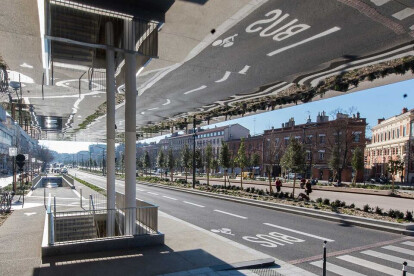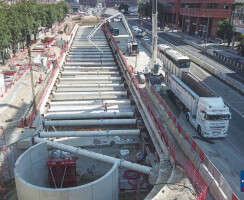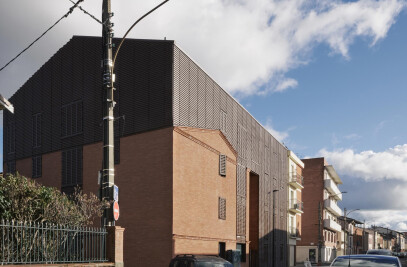The hereby presented project consists of the construction of a public underground carpark of 400 spaces, built underneath the metro tunnel, at the top section of the allées Jean Jaurès in Toulouse (Occitanie region, France).
The allées Jean Jaurès are the Champs Elysées of Toulouse. From 1824 to 1960, called the allées Lafayette at the time, they had a grand central pedestrian fairway flanked on either side by motor vehicle lanes and the tramway lines: it was the toulousain Ramblas. In 1960, the landscaped pedestrian area is cleared to make way for the tarmacked road dedicated to motor vehicles: the allées Jean Jaurès we know today.
Currently, the allées are part of the larger scale urban project led by Joan Busquets in Toulouse, aiming to restore the status of the allées as a remarkable public space and to reaffirm the link the allées creates between the station area as a portal to the city and the historic centre.
The underground carpark is located on the northern section of the allées Jean Jaures, close to the Matabiau train station. Aside from being dominated by cars, the allées are invaded by an accumulation of emerging elements, and has only three pedestrian crossings. These emerging elements provide no added worth to the quality of the public space, but rather are the result of technical needs such as electrical transformers, publicity panels, recycling bins, public toilets, ventilation shafts, bus stops etc. They litter the path without sense or hierarchy, or any combining of uses.
The urban project for the allées by Joan Busquets recreates the pedestrian ramblas in the centre of the road, meaning a reconfiguration of the motor vehicle lanes; the allées become once more pedestrian dominant.
The construction of a new underground carpark necessitated the creation of new technical emergences at the surface of the allées. These were designed at the same time as the design of the global urban project, the objective being that the two designs be completely interfaced and become a whole.
The carpark is a simple rectangular form of 30m by 155m (internal dimensions, ramps excluded) on two underground levels. The internal circulation within the carpark is managed by two circular ramps. This amounts to a total surface area of 10 005m².
The pedestrian accesses to the carpark were strategically positioned so as to facilitate new multiple uses and sequences in the new layout of the allées.
The location of the pedestrian access buildings were planned so as to be integrated into the new design of temporary and permanent facilities.
The objective was to offer a chance of combined uses and elements so as to free up space and to renew the potential of inhabiting this space as it was historically on the allées Lafayette. The combining of uses can take on many forms. The town council can plug seating, bike racks or even publicity panels into the pedestrian access areas of the carpark. Future installations linked to the train stations can also be accommodated, such as information panels or ticketing machines.
The canopy is designed with this in mind, to create a covered area that can accommodate these future installations of combined uses. The canopy is supported by two pillars along the staircase as well as the elevator shaft. An inverted beam constitutes the main structural element of the canopy.
Perceived as one single element, the roof, of which the underside is smooth, reflects the light off the polished stainless steel surface. The roof seems to be held up by only the main beam supported by two pillars. The elevator shaft, cladded by a different material seems to be an independent volume slipping in underneath the canopy.
The pedestrian accesses are integrated into the general urban project of the allées by the use of stone between the stainless steel staircase railing and the groundcover layout drawn up by Joan Busquets. The installation of seating, integrated publicity and information panels can be designed and installed into the covered area of the pedestrian access by the town council as and when needed.

































